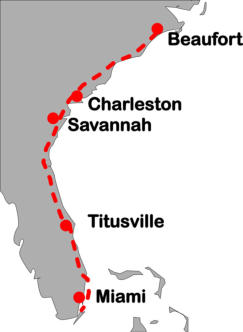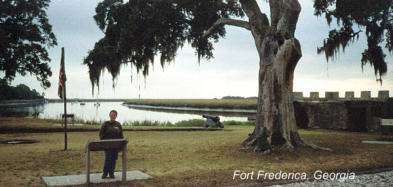Chapter 5
IN WHICH WE FIND THE SUNSHINE
Nov to Dec 1991
The cold weather continued as we left Beaufort NC, 5°C and showers. We were held for two and a half hours at the Marine
Corps firing range at Camp Lejeune because of military exercises; these long delays are a cause of much complaint as there
is no advance warning—one could have slept in for an extra couple of hours! Southport NC used to have a convenient
family operated downtown supermarket that would deliver to the harbour but this is now gone and it is a mile and a half
hike out to the mall for groceries. Just south of Southport another cold front came through and we spent a day listening to
the rain and the wind howling in the rigging.
Just south of the North Carolina—South Carolina border there is a long boring land cut behind Myrtle Beach. They have
now built a big mall with dockage on the Waterway but we did not stop; the docks were exposed to wakes and from what
we could see the stores were mostly touristy boutiques and not useful ones like supermarkets and hardware stores.
On Remembrance day we had a cheer as the temperature broke 15° for the first time in a couple of weeks at Georgetown
SC. Here you can phone the Piggly Wiggly store (yes, this is the name of a southern supermarket chain) and they will pick
you up and drive you to the mall and return you to the boat with your groceries.
Between Georgetown and Charleston was at times like travelling through a war zone with rows of broken and defoliated
trees left from Hurricane Hugo two years ago. In Charleston itself the municipal marina has still not reopened and they
have built a new 55' highway bridge just south of the Ashley marina so boats with tall masts are out of luck and have to
anchor out. This same bridge continues on across the Waterway with a fixed bridge that will have the standard clearance of
65' but during construction this clearance is reduced to 55' by scaffolding. Every low tide saw a number of yachts inching
through with eyes aloft. Charleston is a lovely old city well worth a visit and has an excellent supermarket a cheap bus ride
from the boat.
In Charleston the weather finally warmed up and we had a good trip
through the wide sounds of South Carolina and Georgia. Another city
worth a visit is Savannah, unfortunately it is not right on the waterway
and the Savannah River has no facilities for yachts. You have to stop
at either Thunderbolt or Isle Of Hope (which has an anchorage area)
and take a (very infrequent) bus; or you can do as we did and bicycle,
it is about eight miles. You will be rewarded by a lovely old city laid
out around a series of small square parks with more spanish moss
than you will probably see in the rest of your life. There is also an
interesting walkway along the refurbished riverfront.
We entered Florida on the 24th November and were greeted by
another cold front that dropped the temperatures to near freezing and
we put on another big push to get further south.
Titusville near Cape Canaveral remains an excellent spot to stock up the boat for the Bahamas as the prices are cheap and
there are two supermarkets close to the waterfront (you can take your groceries back to the harbour in a shopping cart, the
supermarkets pick them up every day) The Titusville Municipal Marina has expanded to take up all of the old anchorage
basin and you now have to anchor outside in the Indian River which can be a bit exposed, but there are free showers at the
marina.
The Indian River was a bit of a disappointment this trip. In the past I have had great sails down this wide river in the
prevailing easterlies, but his time we spent three days motoring into southerly headwinds. Just south of St Lucie inlet there
is a great anchorage in Peck Lake. The chart shows no depths, but you will see other boats anchored in the south east part
of the lake. Take the dinghy ashore to the sand beach and you will find a lovely ocean beach on the other side.
There is a good anchorage at the north end of Lake Worth off North Palm Beach, very close to an excellent supermarket.
You will however need a lock on your dinghy and motor as the tie up area is not secure.
Below Palm Beach the waterway becomes too crowded with
too many drawbridges to be enjoyable so we sailed on south
on the outside in the tropical blue ocean about a quarter
mile offshore, picking up some back eddies from the gulf
stream. We pulled in overnight at Fort Lauderdale and the
next day sailed on past Miami Beach with its palms and
pastel hotels and (it being a weekend) dozens of high
powered motorboats roaring up and down the beach
impressing the girls. Off Miami entrance we passed the wing
sailed trimaran Planesail going the other way but in four
knots of wind she wasn't doing anything exciting. We went through Biscayne Channel into the Bay and the next day sailed
on to Barnes Sound where we anchored off the Manatee Bay Boatyard run by ex-TMCCers Hans and Lou vanRijn and
where our friends David and Neila are still rebuilding their catamaran Windchime after its encounter with the Venetian
Causeway bridge in Miami which you may have read about in Multihulls Magazine.
And that's it for the Atlantic Intracoastal Waterway folks, every year brings something different. Each year a couple more
draw bridges are replaced by high level bridges, but those that remain become more restricted in their openings; very few
are still "on demand'' at all times. And the restrictions vary according to time of year, day of the
week and time of day. All this is posted in fine print on the side of the bridge. A current Waterway
Guide may have most of it right. One good thing though is that all the bridges now have radios
and monitor channel 13 so you can call and ask for their next opening time. I think we only had to
use our horn once for a bridge I couldn't raise on the radio. Commercial traffic on the Waterway
(mostly tugs and barges) also communicate on 13. Coming
upon a tug in a narrow or winding channel it is a good idea to
give them a call and ask on which side they would like you to
pass. If you want to sound like an old hand you can offer "a one
whistle pass, cap'n'' (port to port). Most, but unfortunately not
all, powerboats will slow down as they pass to give you
minimum wake, and it is good manners, if they do, for you to
slow down also so that they can pass quickly and get back up to
their cruising speed. You will also make bridge tenders happy
(and they have a thankless job) if you close up with other boats
ahead or astern so that they can open for a shorter time.
We've finally found the warm sunshine we have been seeking.
Fluffy clouds are visible over the gulf stream to the east and
pelicans roost in the mangroves and spoonbills soar overhead. We will probably be here
for a month doing some maintenance on Oborea and relaxing and then it will be off to
the Bahamas.



